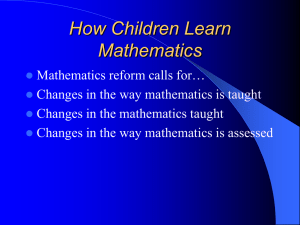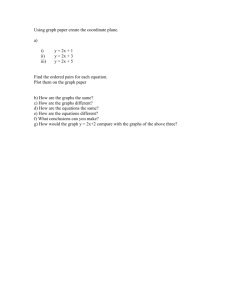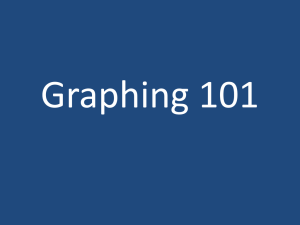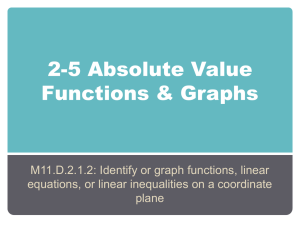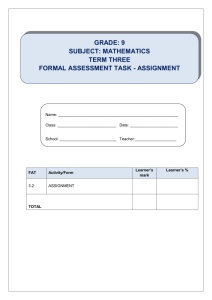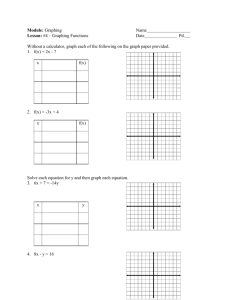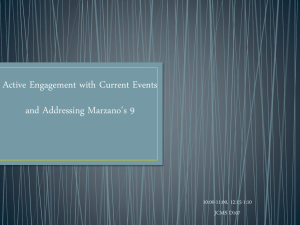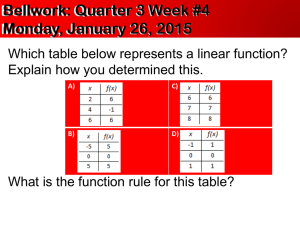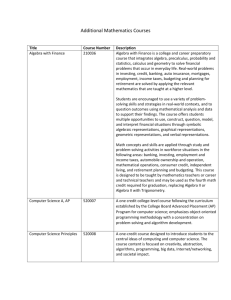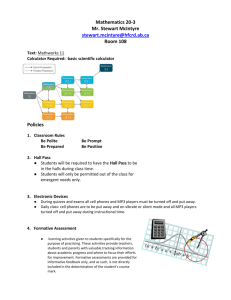The recent release of a data-analysis software tool, TinkerPlotsTM
advertisement
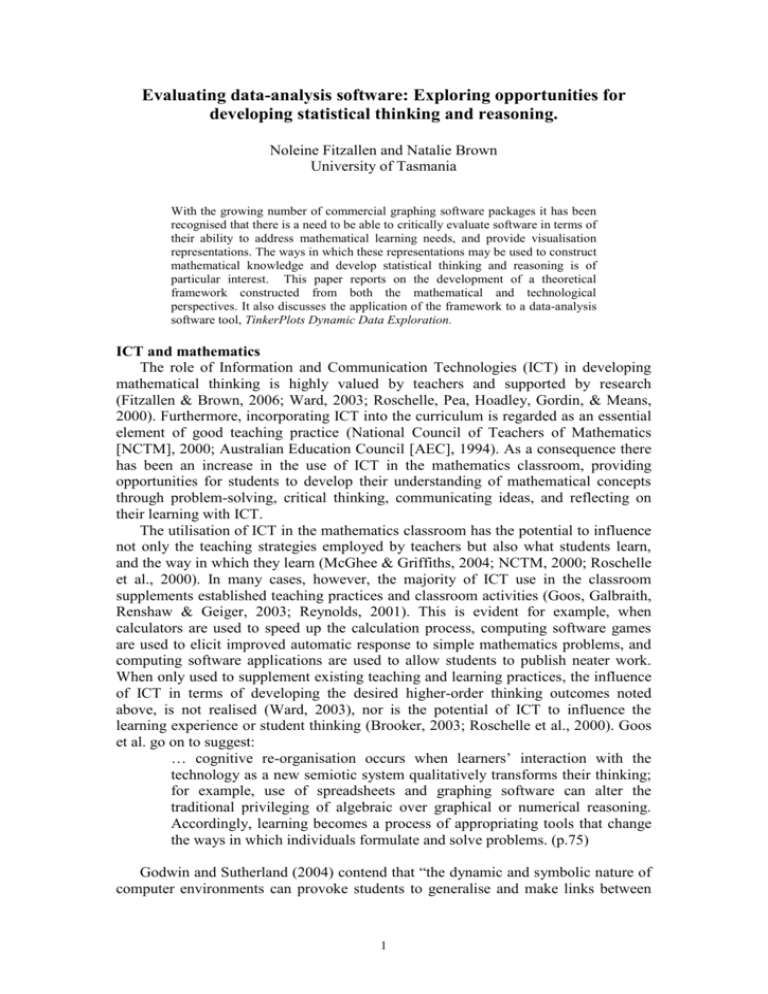
Evaluating data-analysis software: Exploring opportunities for developing statistical thinking and reasoning. Noleine Fitzallen and Natalie Brown University of Tasmania With the growing number of commercial graphing software packages it has been recognised that there is a need to be able to critically evaluate software in terms of their ability to address mathematical learning needs, and provide visualisation representations. The ways in which these representations may be used to construct mathematical knowledge and develop statistical thinking and reasoning is of particular interest. This paper reports on the development of a theoretical framework constructed from both the mathematical and technological perspectives. It also discusses the application of the framework to a data-analysis software tool, TinkerPlots Dynamic Data Exploration. ICT and mathematics The role of Information and Communication Technologies (ICT) in developing mathematical thinking is highly valued by teachers and supported by research (Fitzallen & Brown, 2006; Ward, 2003; Roschelle, Pea, Hoadley, Gordin, & Means, 2000). Furthermore, incorporating ICT into the curriculum is regarded as an essential element of good teaching practice (National Council of Teachers of Mathematics [NCTM], 2000; Australian Education Council [AEC], 1994). As a consequence there has been an increase in the use of ICT in the mathematics classroom, providing opportunities for students to develop their understanding of mathematical concepts through problem-solving, critical thinking, communicating ideas, and reflecting on their learning with ICT. The utilisation of ICT in the mathematics classroom has the potential to influence not only the teaching strategies employed by teachers but also what students learn, and the way in which they learn (McGhee & Griffiths, 2004; NCTM, 2000; Roschelle et al., 2000). In many cases, however, the majority of ICT use in the classroom supplements established teaching practices and classroom activities (Goos, Galbraith, Renshaw & Geiger, 2003; Reynolds, 2001). This is evident for example, when calculators are used to speed up the calculation process, computing software games are used to elicit improved automatic response to simple mathematics problems, and computing software applications are used to allow students to publish neater work. When only used to supplement existing teaching and learning practices, the influence of ICT in terms of developing the desired higher-order thinking outcomes noted above, is not realised (Ward, 2003), nor is the potential of ICT to influence the learning experience or student thinking (Brooker, 2003; Roschelle et al., 2000). Goos et al. go on to suggest: … cognitive re-organisation occurs when learners’ interaction with the technology as a new semiotic system qualitatively transforms their thinking; for example, use of spreadsheets and graphing software can alter the traditional privileging of algebraic over graphical or numerical reasoning. Accordingly, learning becomes a process of appropriating tools that change the ways in which individuals formulate and solve problems. (p.75) Godwin and Sutherland (2004) contend that “the dynamic and symbolic nature of computer environments can provoke students to generalise and make links between 1 their intuitive notions of mathematics and the more formal aspects of mathematical knowledge” (p.132). Hoyles, Noss, and Kent (2004) suggest, together with Goos et al. (2003), that the use of ICT can transform student thinking, extending beyond the immediate concerns of the learning experience to an abstraction of the mathematical concepts with student understandings being shaped by the technology used. However, Hoyes et al. warns of the complexity that technology brings to learning experiences and notes that it places many demands on students, both mathematical and technological. Clearly this is a consideration for teachers when choosing technology to support learning. Guidelines to evaluate critically existing software and guide the development of better software in the future have been advocated by Biehler (1997) and Shaughnessy (2006). In addition, evaluation of software design drawing on relevant learning theories has more recently been recognised by Goos and Cretchley (2003) particularly with respect to developing higher order thinking. In the specific field of statistics education, Shaughnessy has similarly recommended that research be conducted to improve our understanding of the features of software that elicit and transform students’ statistical thinking and reasoning. These calls indicate a continuing need to evaluate software not only from a technological perspective but also from the point of view of how it may contribute to developing statistical concepts for students. ICT and statistics In relation to statistics education, skills associated with the construction and reading of graphs as well as data analysis is included in the curriculum for all the years of compulsory schooling in Australia (AEC, 1994). Graphs are critical for data representation, data reduction, and data analysis in statistical thinking and reasoning (Shaughnessy, 2006). Traditionally, the teaching of statistics had an emphasis on computations, formulas, and procedures such as constructing graphs. The inclusion of technology in the learning experience has led to a shift towards the ability to interpret, evaluate, and flexibly apply statistical ideas (Ben-Zvi, 2000). This has significant pedagogical implications. Teaching and learning of experiences in statistics education can be enhanced by the application of software tools (Biehler, 1997). In particular, graphing software provides the opportunity for students to create and change representations and “…this may lead to exploration of important mathematical concepts” (Goos & Cretchley, 2003, p. 153). The features of graphing software enable students to move efficiently from tabular and graphical representations to the visualisation of data. They also allow students to design multiple graphical representations of the same data set quickly and more accurately than with pen and paper (McGehee & Griffiths, 2004). Konold and Higgins (2003) completed a literature review on how students reason about data. They reported that students should begin with graphs in which they can retrace each individual data value and should also have the opportunity to construct graphs from primary data. Software with these characteristics is described as “bottomup software”. The contention is that this type of software may promote student engagement that assists them to construct meaning from the data (Ben-Zvi, 2000). This is clearly preferable to using software that produce accepted graphical representations, such as histograms, at the click of a button, without providing the opportunities to develop the relationship between the data and the graphical representations (Konold & Higgins, 2003; Biehler, 1997). Sivasubramaniam (2004) suggests that the software or computing device used to display graphs takes over some of the cognitive processes employed to create 2 graphical representations, thereby allowing students to focus on the interpretation of the graphs. He maintains the view that computing devices such as a graphing calculator distributes the cognitive process of creating graphs differently than when producing graphs with pen and paper. He describes this as the “effect of the technology” because the graphing calculator determines the scale and performs the mechanics of creating graphs. Sivasubramaniam does not, however, extend his discussion into what features of the graphing software and subsequent graphical representations contribute to students developing an understanding of the statistical concepts explored, other than the ability of the technology to provide a concrete model. Evaluating software packages The increased use of ICT identified by teachers for their application in graphing activities has led to great increases in the availability of commercial software packages. Drawing on research, critical examination of software is necessary to determine how well they meet teaching and learning needs. This is not only in terms of technology – how user friendly is the package? – but also in what ways the software facilitates the learning of mathematical concepts. In the case of statistics education, a wealth of literature exist describing key elements of best practice teaching to develop statistical thinking and reasoning (Ben-Zvi & Garfield, 2004) and in particular, graphing (Shaughnessy, 2006). This paper will detail the development of a theoretical framework to evaluate software that incorporates those elements together with the elements of software that provide meaningful visual representations (Kidman & Nason, 2000), whilst also considering the capacity of software to influence distributed cognition (Sivasubramaniam, 2004). Model of graphing in an ICT environment The following theoretical framework detailed in Table 1 (Fitzallen, 2006) was developed by considering models of statistical thinking and reasoning in relation to graphing and graph sense-making. A comprehensive consideration of the relevant literature was undertaken to identify theoretical models of statistical thinking and reasoning that were directly related to data analysis and in particular, graphing. Models developed by Friel, Curcio and Bright (2001), Mooney (2002), and Moritz (2004) were considered. Suggestions by Shaughnessy, Garfield & Greer (1996) for an additional level to be added to Friel, Curcio and Bright’s levels of thinking and the notion of transnumeration presented by Pfannkuch and Wild (2004) provided an extensive view of the development of graphing and graph sense-making. It was established from the literature review that although each of the models had elements that were relevant, none of the models took into consideration the way in which students learn in technological environments and how those environments may impact on the construction of mathematical knowledge. The key elements extracted from each of the models were grouped into four interconnected categories: Being creative with data, Understanding data, Thinking about data, and Generic knowledge. Another important feature that sets the Fitzallen (2006) model apart from the others utilised in its development is that it recognises that there are some generic understandings inherent in all levels of data analysis, graphing and graph sensemaking. In so doing, the model progresses from being a hierarchical model and aligns more with the notion that learning experiences in relation to data analysis can be accessed from multiple entry points (Moritz, 2004). Although the application of technology in the data analysis process was considered, the Fitzallen model does not 3 take into consideration specific visual representations and how they may contribute to the understanding of statistical concepts. Understanding the dynamic nature of software and technology environments Thinking about data Recognising the components of data and graphs Understanding data Speaking the language of graphs Table 1: Model of graphing in an ICT environment Category Generic Knowledge Descriptors of Category Being creative with data Reducing data to graphical representations or statistical summaries. Constructing different forms of graphs. Translating verbal statements into graphs. Making sense of data and graphs. Understanding the relationship among tables, graphs, and data. Identifying the messages from the data. Answering questions about the data. Recognising appropriate use of different forms of graphs. Describing data from graphs. Asking questions about the data. Recognising the limitations of the data. Interpreting data and making causal inferences based on the data. Looking for possible causes of variation. Looking for relationships among variables in the data. Principles for analysing visual representations Similar to the process undertaken by Fitzallen (2006), a review of research literature in relation to analysing visual representations was conducted by Kidman & Nason (2000). The review determined that visual representations can facilitate the construction of mathematical knowledge in four ways: i. visual representations can provide the source for mathematical analogs; ii. visual representations can act as tools to facilitate problem solving; iii. visual representations can facilitate mathematical meaning-making; and iv. computer-based visual representations can act as tools for supporting and reorganising thinking. Kidman and Nason (2000) determined that existing frameworks did not take into consideration research findings from the fields of semiotics and computer-based visual representations as tools for supporting and reorganising thinking. The integration of these factors with existing frameworks resulted in the development of Principles for Analysing Visual Representations. The seven principles were applied successfully by Kidman and Nason as a diagnostic tool to determine the effectiveness of dynamic mathematical representations employed within Integrated Learning Systems (computer-based learning activities). Although the Principles for Analysing Visual Representations (Kidman & Nason, 2000) is a good framework for the general analysis of mathematical software, in order to be considered for use with statistical software the principles need to be more specific for evaluating the capacity of software to facilitate the development of statistical concepts. 4 Aspects of Statistical Software The limitations of presented frameworks – Fitzallen (2006) looking more broadly at statistical thinking and reasoning without reference to the impact of visual representations, and Kidman and Nason (2000) considering technology in relation to mathematics in general, led to the melding of the two frameworks. The new framework, Aspects of Statistical Software, is presented in Table 2. The relationship between the literature and the elements of the framework are noted in the last column. Table 2. Aspects of Statistical Software No. Aspects 1 The interface is accessible and features of the software are easy to use. It is easy for students to enter data and understand how it is represented by the software. 2 Software assists recall knowledge and data can be represented in different and multiple forms. Students can access both graphical representations and numerical data 3 4 5 6 Reference/s Kidman & Nason (2000), Principle 1 Kidman & Nason (2000), Principles 1 & 5, Fitzallen (2006), Being creative with data, Understanding data Software facilitates the process of translating between Kidman & Nason (2000), mathematical expression and natural language. Principle 6, Students can maintain the relationship between the Fitzallen (2006), Being creative with data context and the data of statistical investigations. Software provides extended memory when organising and Kidman & Nason (2000), reorganising data. Principle 4, Students can display and manipulate data easily in Fitzallen (2006), Being creative with data, creative ways. Understanding data, Sivasubramaniam (2004), Distributed cognition Software provides physical/iconic environment that Kidman & Nason (2000), provides multiple entry points for abstraction of concepts. Principles 3 & 5, Fitzallen (2006), Being Students can go between data, tables, and graphs, creative with data, developing an understanding of the relationship Understanding data between the different forms of data. Visual representations used for both interpretative and Kidman & Nason (2000), expressive learning activities. Principles 2 & 7, Fitzallen (2006), Thinking Allows students to interpret data and make causal about data links between and within data. Students can ask questions about the data based on the visual representations. The new framework (Table 2) progresses the work of Kidman and Nason (2000) by specifically considering pedagogical content knowledge related to statistics education. The work of Sivasubramaniam (2004) has also been considered. In particular, the capacity of technology to reduce cognitive load by performing the mechanics of creating graphs, thereby, allowing students to concentrate on understanding the graphical representations. Although underlying understanding is a key aim addressed by other frameworks, including the notion of distributed cognition is a genuine ‘plus’ and allows for the focus to be on understanding. It should also be recognised that each of the three sections of the Generic knowledge of the Fitzallen (2006) model permeate through all aspects of the framework. 5 Evaluating software against the framework The research project, from which this report is taken, utilises recently released data-analysis software, TinkerPlots Dynamic Data Exploration (Konold & Miller, 2005). TinkerPlots provides educators with a graphing program that is designed specifically for students in the middle years of schooling and gives students an intuitive, informal set of operators to organise data flexibly to see patterns in them. Of particular note, is the way in which explorations are performed without necessarily having to learn first to make and interpret a standard set of graph types. Early indications from research (Shaughnessy, 2006; Konold & Higgins, 2003; Hammerman & Rubin, 2002) and anecdotal evidence (Konold & Miller, 2005) support the conviction that TinkerPlots will be useful in developing students’ understanding of statistical concepts. It is, however, important to evaluate critically TinkerPlots using relevant theories of statistical thinking and reasoning as well drawing on frameworks that evaluate the visual representations afforded by TinkerPlots. This will be of assistance when determining in what ways TinkerPlots may assist students to construct mathematical knowledge. Evaluation of TinkerPlots against the framework Aspect 1. When initialised, TinkerPlots presents a clean and uncluttered interface. The screen consists of a blank white page with a menu bar at the top of the screen. To the novice user the blank screen is a little confronting as there are no visual clues as to where to start. The user’s first reaction is to go to the menu with the expectation that it will be a drop down menu similar to other software applications. This is not the case. TinkerPlots utilises a drag and drop function to import data representations onto the screen. As the user becomes familiar with the drag and drop function the manipulation of graphs and data values becomes extremely easy. To assist the user TinkerPlots has an extensive ‘Help’ section which is easy to use. Additionally, the software has four tutorials demonstrating and explaining the basic features of the software included within the program. These are in the form of movies which only run for a few minutes each. The availability of the tutorials within the program enables the user to access the tutorials at any time, to refresh the user’s understanding of how to utilise the features of the software. Aspect 2. TinkerPlots includes a stacked data card system in the plot window for the organisation of case-based data. Information about the characteristics (variables) of an individual case is presented on a single card and there is one card for each case in a data set. Data entered into the data cards are automatically entered into a spreadsheet and graphical representations can be constructed from both the data cards and the spreadsheet. There is the option of entering the data directly into the spreadsheet table. This facility will create the stacked data cards automatically. Aspect 3. The interface of TinkerPlots allows students to create multiple graphical presentations, import digital images, display tables of results, and add written commentaries into the one file as they conduct statistical investigations. The context of the learning experience is transferred to the software interface easily, allowing for the user to construct an understanding of a statistical investigation by maintaining the relationship of the context between the data and the graphical representations. Direct access to the graphical representations and the ability to contribute written responses to the interface facilitates the use of the language of graphs. 6 Aspect 4. Many features of TinkerPlots assist in distributing the cognitive load of processing data between the user and the software, allowing the user to focus on the interpretation of the data rather than the creation of the graphs (Sivasubramaniam, 2004). This is demonstrated when data points in a graphical representation in TinkerPlots are manipulated by the drop and drag function in order to change the scale of the graph and the graphical representation. Changes are quick and fluid, and are viewed as animations. Additionally, the transformation of a dot plot to a histogram is made easily by changing the shape of the icons representing the data from a dot to a fused bar. Actions such as these change the scale and the form of the graph quickly. Although the scale is determined initially by the software it can be changed by the user to represent a different range. Other functions such as mean, mode and median also allow the user to focus on understanding the data when using TinkerPlots. As with most of the features in TinkerPlots that are for interpreting data, they are accessed on the main menu bar. The numerical calculations for these concepts of centrality are performed automatically by the software and are represented on graphs by an icon and/or numerical value. This allows students to explore what these concepts mean in terms of the data without having to focus on the rules for determining the numerical value. This is also the case when utilising the hat plot function (TinkerPlots version of a box plot) Aspect 5. An outstanding feature of TinkerPlots is the way a set of data can be explored in many ways. Graphs can be constructed by dragging and dropping the names of the variables from either the data cards or the spreadsheet into a plot window. Graphs can be constructed to explore the distribution of data as well as covariation. Once a graph is constructed for one variable it can be changed to represent a different variable by dragging the new variable name onto the axis of the graph in the plot window. Additionally, highlighting individual data points on a graph will automatically display the data card associated with that particular data point on the top of the data cards. It also highlights the data associated with that point in the spreadsheet. This can potentially help the user to build an understanding of the relationship between the data and the graphical representations. Aspect 6. TinkerPlots provides for both interpretative and expressive learning activities. Expression is the process of crafting visual representations to convey meaning (Kidman & Nason, 2000). The program enables students to build meaning from the data by being able to “create both simple and complex graphs by performing actions such as sorting data into categories or ordering the information according to the values of one of the variables” (Hammerman & Rubin, 2002). In relation to interpretative activities, the box plot, mean, median, sorting and filtering of data functions all contribute to the way the user can interpret data. An additional feature that facilitates the interpretation of data is the way in which the software displays the data in multiple categories within the same graph. This can lead to the interpretation of the association of variables within and between data. Conclusion This paper has drawn on a model of statistical thinking and reasoning (Fitzallen, 2006), a framework for evaluating software (Kidman & Nason, 2000), and the notion of distributed cognition in relation to technology (Sivasubramaniam, 2004) to develop a framework for the evaluation of data analysis software. The framework, Aspects of 7 Statistical Software, was used to evaluate TinkerPlots Dynamic Data Exploration (Konold & Miller, 2005). It was determined that TinkerPlots promotes the opportunity for students to be involved in the data analysis process. This begins with the input of the data into a spreadsheet or data card system, moves to the creation and manipulation of graphical representations, and extends to the interpretation of graphs through using box plots and other means of summarising data. It provides visual representations that provide immediate feedback to students as the animations of changes instigated are fluid and quick. Throughout the process the user is in control of the functions and maintains the connection between the data and the graphical representations. A student participating in a research project investigating students’ development of key statistical concepts - comparing distributions and comparing samples – explained TinkerPlots in the following way: It is sort of like a graphing sort of system that can be used to figure out that you can make graphs out of and actually, it is pretty fun, too. It is sort of like, … it’s got the same sort of things as any other sort of graphing thing but you actually make the graph yourself instead of entering all the numbers in and the computer does it for you. Bakker & Frederickson (2005, p. 88) Clearly, TinkerPlots shows evidence of offering a dynamic learning environment for students. It appears to cater effectively for middle school students and has obvious advantages as an educational tool. It is, therefore, pertinent to explore the ways in which students engage in the software and use it to analyse, display, and interpret data. The research project from which this paper is taken will explore how TinkerPlots contributes to and promotes the development of statistical concepts for middle school students. Acknowledgements: This research is funded by an APA(I) Scholarship associated with an ARC Linkage Project LP0560543 and the industry partner, Department of Education, Tasmania. 8 References Australian Education Council. (1994). Mathematics - A curriculum profile for Australian schools. Carlton, Vic.: Curriculum Corporation. Bakker, A., & Frederickson, A. (2005). Comparing distributions and growing samples by hand and with a computer tool. In W.J. Masalski, & P.C. Elliot (Eds.), Technology-supported mathematics learning environments, (pp.75–91). Reston, VA: NCTM Ben-Zvi, D. (2000). Toward understanding the role of technological tools in statistical learning. Mathematical Thinking and Learning, 2(1&2), 127-155. Ben-Zvi, D., & Garfield, J. (2004) The challenge of developing statistical literacy, reasoning and thinking. Dordrecht: Kluwer Academic Publishers. Biehler, R. (1997). Software for learning and for doing statistics. International Statistical Review, 65, 167-189. Brooker, L. (2003). Integrating new technologies in UK classrooms: Lessons for teachers from early years practitioners. Childhood Education, 79(5), 261 -266. Committee for the Review of Teaching and Teacher Education (2003). Australia's teachers: Australia's future - Advancing innovation, science, technology and mathematics. Canberra: Author. Fitzallen, N. & Brown, N. (2006). What profiling tells us about ICT and professional practice. In Creative Dissent: Constructive Solutions. Proceedings of the Australian Association for Research in Education International Educational Research Conference, 2005, Parramatta. Retrieved April 3, 2006, from http://www.aare.edu.au/05pap/fit05121.pdf Fitzallen, N. (2006). A model of students’ statistical thinking and reasoning about graphs in an ICT environment. Manuscript submitted for publication. Friel, S. N., Curcio, F. R., Bright, G. W. (2001). Making sense of graphs: Critical factors influencing comprehension and instructional implications. Journal for Research in Mathematics Education, 32, 124-158. Godwin, S. & Sutherland, R. (2004). Whole-class technology for learning mathematics: The case of functions and graphs. Education, Communication and Information, 4(1), 131-152. Goos, M. & Cretchley, P. (2003). Computers, multimedia, and the internet in mathematics education. In B. Perry, G. Anthony, & C. Diezmann (Eds.) Research in mathematics education in Australasia 2000-2003 (151-174). Sydney: MERGA. Goos, M., Galbraith, P., Renshaw, P., & Geiger, V. (2003). Perspectives on technology mediated learning in secondary school mathematics classrooms. Journal of Mathematical Behaviour, 22(1) 73-89. Hammerman, J., & Rubin, A. (2002). Visualizing a statistical world. Hands On!, 25(2). Retrieved August, 11, 2005, from http://www.terc.edu.handsonissues/fo2/stats_world.html Hoyles, C., Noss, R., & Kent, P. (2004). On integration of digital technologies into mathematics classrooms. International Journal of Computers for Mathematical Learning 9, 309-326. Kidman, G. & Nason, R. (2000). When a visual representation is not worth a thousand words. In M. Thomas (Ed.), Proceedings of TIME 2000, an International Conference on Technology in Mathematics Education (pp. 178-186). Auckland: The University of Auckland and Auckland University of Technology. Konold, C., & Higgins, T.L. (2003). Reasoning about data. In J. Kilpatrick, W.G. Martin, & D. Schifter (Eds), A research companion to principles and standards for school mathematics (pp. 193-215). Reston, VA: National Council of Teachers of Mathematics. Konold, C. & Miller, C.D. (2005). TinkerPlots: Dynamic data exploration. Emeryville, CA: Key Curriculum Press. Little, J., & Williams, M. (2001). Redefining quality: What is the content of a knowledge work focus in all curriculums, and how do we help students engage with this content? In Proceedings of the National Conference on Quality Teaching: Improvement or Transformation? Canberra: Dept. of Education, Science and Training. McGehee, J., & Griffith, L.K. (2004). Technology enhances student learning across the curriculum. Mathematics Teaching in Middle School, 9(6) 344-349. McClain, K. (1999). Reflecting on students: Understanding data. MathematicsTteaching in the Middle School, 4(6), p.374-379. Mooney, E.S. (2002). A framework for characterizing middle school students’ statistical thinking. Mathematical Thinking and Learning, 4(1), 23-63. Moritz, J.B. (2004). Reasoning about covariation. In D. Ben-Zvi & J. Garfield (Eds.), The challenge of developing statistical literacy, reasoning and thinking (pp. 227-255). Dordrecht: Kluwer Academic Publishers. 9 National Council of Teachers of Mathematics. (2000). Principles and standards for school mathematics. Reston, VA: NCTM. Pfannkuch, M., & Wild, C. (2004). Towards an understanding of statistical thinking. In D. Ben-Zvi, & J. Garfield, (Eds.), The challenge of developing statistical literacy, reasoning, and thinking (pp. 17-46). Dordrecht, Netherlands: Kluwer Academic Publishers. Reynolds, D. (2001). ICT in education: The future research and policy agenda. In Proceedings of the Building an ICT Research Network Conference. Retrieved April 29, 2004, from http://www.becta.org.uk/research/reports Roschelle, J.M., Pea, R.D., Hoadley, C.M., Gordin, D.N., & Means, B.M. (2000). Changing how and what children learn in school with computer-based technologies. The Future of Children, 10(2) 76102. Shaughnessy, J. M., Garfield, J., & Greer, B. (1996). Data Handling. In A. J. Bishop, K. Clements, C. Keitel, J. Kilpatrick, & C. Laborde (Eds.), International Handbook of Mathematics Education (pp. 205-237. Dordrecht, The Netherlands: Kluwer Academic Publishers. Shaughnessy, J.M. (2006). Research on statistics learning and reasoning. Manuscript submitted for publication. Sivasubramaniam, P. (2004). Distributed cognition and the use of graphing calculators in the learning of mathematics. In Proceedings of the 2nd National Conference on Graphing Calculators, Penang, October 4-6, p. 93-103. Retrieved August 24, 2005, from http://www.mat.usm.my/math/Events/NCGC04Proc/PDF/SPumadevi.pdf Ward, L. (2003). Teacher practice and the integration of ICT: Why aren’t our secondary school teachers using computers in their classrooms? In Educational Research, Risks, & Dilemmas. Proceedings of the Conference of the joint New Zealand Association for Research in Education and Australian Association for Research in Education, Auckland. [CDROM]. 10
